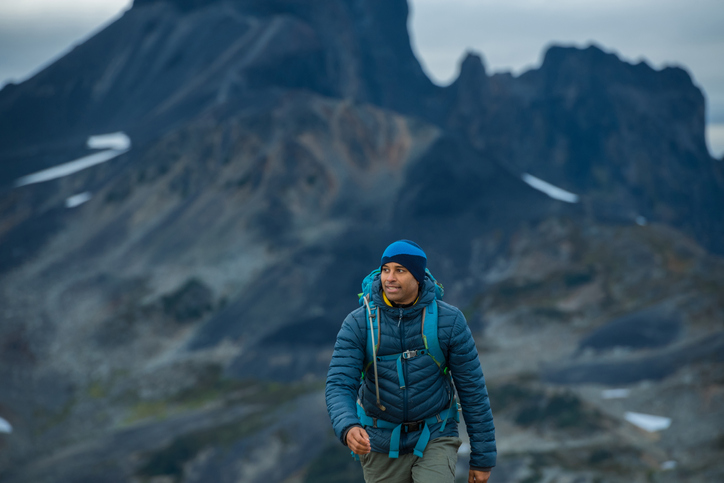Glamorous beach vacations in Bimini and sophisticated trips to metropolitan cities like Paris usually dominate your TikTok and Instagram feeds. But not everyone wants to lay on a beach or put on for the ‘gram when they submit their vacation request. Some people like to get back to nature and explore the world around them in the most literal sense of the word.
Sure, you can book a quick day trip to the nearest national park, but some people want to take that a step further. Specifically, have you considered trekking along a multi-country hike? As the name implies, these are hiking trails that transverse multiple countries. Ranging anywhere from as little as 170 miles to as much as 3,100 miles, if you’re ready to get your nature badge, these eight multi-country hiking trips can help you reconnect with the land.
The Appalachian Trail
If you’re not ready to book adventurous weeks or months-long backpacking trips through other countries, there’s nothing wrong with starting closer to home. The Appalachian Trail (AT) is located on the eastern seaboard of the United States, winds through many of the original 13 colonies, and covers more than 2,190 miles. While the Appalachian mountains aren’t as extreme as the Rockies, novices shouldn’t attempt to hike the entire trail. To hike it from beginning to end, you’ll either need to start in Georgia or Maine.
Most adventurers prefer Georgia as their starting point. Just beware that this can translate into a crowded hiking trail during warm weather months. To fully traverse the trail, you better take a sabbatical as it takes five to seven months to complete and requires significant planning. Usually, only a quarter of all hikers successfully complete this traveling feat. The Appalachian Trail Conservancy recommends that hiking hopefuls register their travel itinerary to avoid overcrowding, receive alerts for potential hazards, and tips to avoid negative ecological impacts on the local flora and fauna.
The Pacific Crest Trail
If you manage to master the Appalachian Trail, you might be ready for what the North American West Coast has to throw your way. The Pacific Crest Trail (PCT) is a 2,653-mile long journey that stretches from just below Campo, California — a mere miles from the U.S.-Mexico border — to Manning Park in British Columbia, Canada. It also incorporates some of the highest portions of both the Cascade and Sierra Nevada Mountains.
Traveling this trail will take you through 25 national forests and seven national parks. This is one of the three massive hiking trails in the U.S. that are part of the Triple Crown of Hiking — the others being the Appalachian Trail and the Continental Divide Trail. Similar to the AT, the Pacific Crest Trail Association has tips for thru-hikers. You can cross this trail on foot or horseback. But be aware that this is not a trail for beginners and is unsafe to travel at times because of snow conditions. The average completion time from end to end is five months with elite athletes completing it in two.
The Continental Divide Trail
Rounding out the Triple Crown of Hiking is the Continental Divide Trail (CDT). This is the official point where water runs in opposite directions in North America to either the Atlantic or Pacific Oceans. If you’ve managed to master AT and PCT, then the CDT is ready to take you from Mexico to Canada.
A thru-hike will take you across 3,100 miles of trail that covers a diverse array of ecosystems and communities. This journey takes you through Glacier National Park, Yellowstone National Park, Rocky Mountain National Park, and several Indigenous reservations — so be sure to secure the appropriate permits. Expect to take five and a half months to complete this trail from end to end. As with the PCT, you should be an expert hiker if you’re attempting to complete the CDT from end to end.
The Tour du Mont Blanc
If you’re fairly confident that you’ve mastered any trail that North America has to offer, then head out to Europe. The Tour du Mont Blanc (TMB) spans three countries (France, Italy, and Switzerland), encompasses the Mont Blanc mastiff, and covers roughly 103 miles.
Most people think this trail is generally less challenging and can be completed in nine to 14 days if you follow the circular counter-clockwise direction. This makes it ideal for those with only a few weeks of vacation time to spare. But if you also want to hit a few cities and not spend your entire vacation on the trail, then there are one-day walking trips too.
The John Muir Trail
Not everyone can afford to take off four or five months to traverse a remote trail. In that case, the John Muir Trail (JMT) is a good alternative that still gives you bragging rights, but takes significantly less time. At just 211 miles long, the JMT runs along the PCT and is located solely within California. Still, you can pass through some of America’s finest national parks including Yosemite, Kings Canyon Sequoia National Park, and the John Muir and Ansel Adams Wildernesses.
Be aware that this still isn’t a day trip hike. Most of your travel will be limited to July through September for safety reasons. Still, this is a challenging trail so novices should steer clear. If you can maintain a good pace and clear at least 10 miles a day, you can complete this trail in three weeks.
Via Dinarica Trail
Dust off your passport and head back to Europe for the Via Dinarica trail located in the Balkans which stretches from Albania to Slovenia, and winds through Croatia, Bosnia, Herzegovina, Montenegro, Serbia, and Kosovo. This is one of the newer multi-country trails on this list and is most definitely for people with plenty of vacation time to use. Choose from three trails, the White Trail, Blue Trail, and Green Trail. However, the Green and Blue Trails are still being developed.
The White Trail is the only fully accessible option and follows along the natural layout of the Dinaric Alps. This path spans roughly 783 miles, starting in the Nanos plateau in Slovenia and ending in the Valbona Valley in the Albanian Alps. Other attractions you can enjoy along the trail include white whitewater rafting, mountain biking and of course, visiting towns along the way. To complete the full White Trail, plan to take off at least two and a half to three weeks as the total trek takes just over 410 hours. Or, you can cheat and opt for a day trip hike instead.
The Kungsleden Trail
If you’re not trying to scale the tallest mountains known to man, head to Sweden to tackle the Kungsleden Trail. At just 270 miles long, this trail doesn’t cross into any other countries but is of moderate difficulty — making it a safer bet for hiking newbies. The best time to hike this trail is between summer and early fall when bad weather is less likely to impact your travel plans.
The trail spans between Hemavan to Abisko in the Swedish mountains. You’ll enjoy gorgeous paths through the Vindelfjällen nature reserve, four national parks, and the Laponia World Heritage. If you have your heart set on a thru-hike, be prepared that this can still take about a month to complete. But, if time doesn’t permit, you can opt to just hike the first section between Abisko and Nikkaloukta which covers around 65 miles and takes about a week to finish.
The GR20 Trail
Most people might only know Corsica as Napoleon’s homeland. But the island nation is also home to a 112-mile trail known as the GR20. Dubbed the toughest trail in Europe, this hike can take around two weeks to complete if you’re in good shape. More seasoned hikers can finish in just under a week. The GR20 crosses north to south across the Corsican mountains, spanning from Calenzana in the north to Conca in the south.
You’ll need to book your trip between June to October to avoid bad weather. But if you want to skip the crowded season, Avoid July and August. Although this trail can seem intimidating thanks to some very rugged mountain peaks, if you’re even moderately experienced as a hiker, this shouldn’t be too difficult for you to conquer. Be forewarned that it’s a good idea to brush up on or learn a little French before attempting this trek as even the official website for GR20 is only available in French.
Questions People Ask
Are multi-country hikes safe?
The better question is how comfortable are you with hiking? Most of these multi-country or even cross-country hikes require a minimum of several days on the trail. You’ll find that all of the official trail websites linked above include information such as resupply stops, safety precautions, and even the best times to attempt a hike so that you avoid common weather-related hazards.
How do I know which trail is best for me?
Even though a few of the hiking trails above are designated as safe for beginners, you also need to consider how much time you’re willing to devote to these types of trips. On the shorter end, some trails only take about a week or two to complete, with longer trails requiring as much as five to seven months. Be realistic about what you can actually accomplish and how committed you are to completing a trail from end to end. Also, note that all of these trails provide details on day trips or short multi-day excursions which might be a better starting point for novices.
Do I need permits to hike these trails?
Yes, you do. However, keep in mind that depending on the trail you select, you might need to secure several permits. For example, the Continental Divide Trail Coalition lists a minimum of five permits that hikers must secure before hitting the trail. Always check with the official trail organization to make sure that you’ve secured the right permits for your trip.
When should I hike these trails?
Almost all of the trails listed above aren’t meant to be traversed in the winter. Snowy weather and dangerous conditions can be life-threatening. You’ll usually find that most of these trails are only permitted for hiking between Spring and the early Fall.
Can I bring children or pets?
In the U.S. most pets usually aren’t allowed on the trail. For all other jurisdictions, you’ll want to check with the official trail websites. Also, many of the trails are challenging hikes and might not be suitable for small or inexperienced children. If you want to bring children, consider skipping a multi-day itinerary and opting for a day trip through calmer parts of your desired trail.
Can I hike these trails alone?
Virtually every trail listed above can be hiked alone if you prefer. However, doing so means that you’re solely responsible for your safety. So, you’ll need to plan accordingly to ensure that you’re not only avoiding risks while hiking, but that you take extra precautions for safety around animals or other people you might encounter on the trail.
Hiking can be a great way to expand your horizons, enjoy new experiences, or even reconnect with yourself or loved ones. If you’re ready for a nature adventure, unlike anything you’ve ever experienced before, the eight multi-country hiking trails listed above are sure to astound both you and anyone who hears your tale. Just be sure to plan accordingly, register your trip with any governing authorities, and secure all proper permits so you can legally enjoy that hike.





